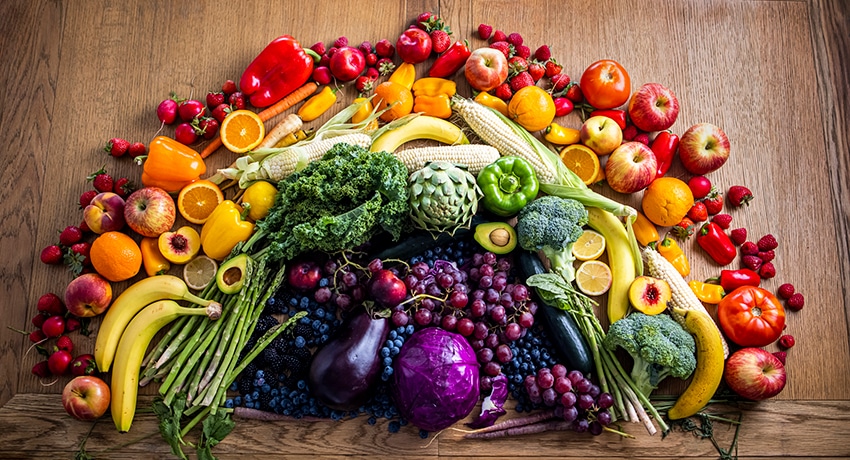Why are fruits and vegetables among the healthiest foods on the planet? Just look at their colors!
All fruits and vegetables pop a distinctive color. This is because all plant-based foods retain phytonutrients, bioactive compounds that protect plants from bugs, fungi, radiation, and other threats. Just as these natural chemicals help plants, phytonutrients help humans fight free radicals (unstable atoms that cause cell damage) in the body with their antioxidant properties.
Because they are full of “fight-o” nutrients, fruits and vegetables not only serve as nourishment but as nature’s medicine.
“Most fruits and vegetables have similar vitamins and minerals; each food just holds more types of nutrients than another. The same goes for phytonutrients,” said Tish J. Wright, RD, certified diabetes care and education specialist at UT Physicians Multispecialty — Bayshore. “In fact, it’s the major type of phytonutrient that gives the food its color. The color of a fruit or vegetable is a good indicator of the phytonutrients it has and some of the vitamins and minerals it contains.”
Learn to read the colors of your produce and understand how the phytonutrients and nutrients inside these powerful foods help fight away sickness.
Red and pink
Red and pink foods receive their rich tints primarily from lycopene, a phytonutrient that signals vitamin C.
“Red fruits and vegetables are loaded in vitamin C, so they boost our immune system. Some of them, like raspberries, cranberries, and tomatoes, are really potent and help fight certain cancers. These foods also have some vitamin A to strengthen our eyes and the cells in our body,” Wright said. “Red foods are beneficial to our hearts.”
· Phytonutrients include anthocyanidins, ellagic acid, hesperidin, lycopene, and quercetin.
· Vitamins and minerals include vitamin A, vitamin C, and potassium.
· Color group supports cells, digestion, heart, immunity, memory, skin/hair, urinary tract, and vision.
· Foods include apple, pomegranate, radish, red pepper, strawberry, and tomato.
Orange and yellow
The bright hue from orange and yellow fruits and vegetables comes mainly from beta-carotene, a phytonutrient that converts into vitamin A.
“The orange and yellow foods, like carrots, squash, and apricots, are good for repairing our cells and tissues. The citruses — an orange, for example — also have vitamin C and folate, which helps prevent birth defects,” the dietitian said. “Yellow foods are great for our skin. Orange foods help guard us from cancers.”
· Phytonutrients include alpha-carotene, beta-carotene, beta-cryptoxanthin, hesperidin, and lutein.
· Vitamins and minerals include vitamin A, vitamin B9 (folate), vitamin C, and potassium.
· Color group supports cells, circulation, heart, immune system, skin/hair, and vision.
· Foods include apricot, carrot, lemon, orange, squash, and sweet potato.
Green
Chlorophyll and lutein give green fruits and vegetables their color. These phytonutrients are linked to several nutrients, such as vitamins A, C, E, and potassium. The darker and leafy greens are considered “superfoods” because they offer even more vitamins and minerals.
“Kale, broccoli, spinach, and Brussels sprouts, for example, have vitamins A, B, C, E, and K — plus iron, calcium, potassium, and manganese. Because they’re so nutrient dense, they help fight cancer and other diseases,” Wright said. “Many green foods help detoxify our bodies.”
· Phytonutrients include epigallocatechin gallate (EGCG), indoles, isoflavones, isothiocyanates, lutein, and sulforaphane.
· Vitamins and minerals include vitamin A, vitamin B9 (folate), vitamin C, vitamin E, vitamin K, calcium, iron, and potassium.
· Supports bones/teeth, cells, healing, heart, and vision.
· Foods include asparagus, broccoli, green grapes, kiwifruit, limes, and spinach.
Blue and purple
Blue and purple fruits and vegetables share a deep pigment called anthocyanin. This phytonutrient reflects a powerful vitamin C punch.
“The blue and purple foods help us fight sickness and replace cells in our brain, bones, and other body parts. They basically help our entire body function longer,” the expert said. “The berries (blueberries and blackberries) are even part of a cancer-fighting diet.”
· Phytonutrients include anthocyanin, flavonoids, phenolics, and resveratrol.
· Vitamins and minerals include vitamin B9 (folate), vitamin C, and vitamin K.
· Supports anti-aging, bones, cells, circulation, heart, memory, and urinary tract.
· Foods include blackberry, blueberry, cabbage, eggplant, plum, and purple cauliflower.
White and brown
Found in white fruits and vegetables, allicin is associated with vitamins A, C, K, and potassium. The compound of this phytonutrient helps control blood sugar, blood pressure, and blood cholesterol.
“Don’t underestimate these foods just because they lack an intense color. The white and brownish fruits and vegetables help us against diabetes and heart disease,” Wright said. “White cauliflower, mushrooms, and garlic are also highly recommended to help prevent and fight cancers.”
· Phytonutrients include allicin, epigallocatechin gallate (EGCG), glucosinolates, indoles, and quercetin.
· Vitamins and minerals include vitamin B9 (folate), vitamin C, vitamin K, and potassium.
· Supports bones/teeth, cells, circulation, heart, immune system, and skin/hair.
· Foods include cauliflower, garlic, ginger, jicama, onion, white nectarine, and white peach.

Colors can help tell the nutrients and phytonutrients in certain fruits and vegetables. Still, no group — or food — contains absolutely everything the body needs.
“For optimum health, your foods really should reflect the colors of the rainbow. Purchase what’s in season, then you’ll get more of a variety. It shouldn’t be hard to find things you like because every color group offers so many different choices,” Wright said. “And as fantastic as they are on their own, fruits and vegetables should be part of a greater, balanced diet that includes some lean proteins, low-fat dairy, and whole grains.”
“Phyte” away sickness. Eat the rainbow of fruits and vegetables!



